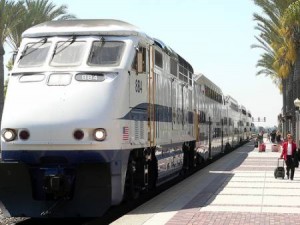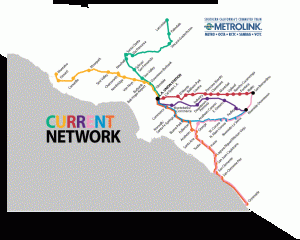Longtime Angeleno Robert L. Davis is back with some follow-up memories of Pasadena rail. As an electric rail fan, he was excited back in the 1990s at the prospect of a new Metro light rail line to Pasadena, what would eventually become the Gold Line. However, he notes in the history that there was discussion of building it as part of Metrolink, the Southern California long-haul commuter rail that started in the early 1990s and shares tracks with freight lines:
Back in the early 1990s, when Santa Fe was in the process of selling of the 2nd District (LA to San Bernardino via Pasadena and Pomona), there was one school of thought among both SCRRA [Southern California Regional Rail Authority, which operates Metrolink] and Metrolink and a coterie of railfans that believed that the line through Pasadena should have been upgraded for faster operation, but should have remained a diesel-powered mostly single track line, which would accommodate both freight and passenger trains meeting FRA standards. This possibility was still under discussion one day when I was a volunteer trainman on a special train run by Orange Empire Railway Museum for SCRRA personnel. They wanted to see the Santa Fe San Jacinto Branch between Perris and Hemet, so we gave them a ride on our ex-Soo Line business car (which has played a political campaign car in movies). During the trip I heard the SCRRA folks discussing making the line through Pasadena a Metrolink route.
I covered the origins of the Gold Line in my book Railtown but did not discuss this possibility. Davis favored a non-diesel train, represented by light rail, over the smelly Metrolink option. I too favor electric transportation generally over diesel.
However, given the expense and amount of time it took to build the Gold Line, coupled with the relatively disappointing ridership numbers due to the slow route and lower population density of the corridor and San Gabriel Valley it serves, I wonder if going with the more expensive light rail was a mistake.
Metrolink was able to get up and running very quickly and cheaply, thanks in large part to a California Environmental Quality Act (CEQA) exemption for new rail on existing freight rights-of-way and the easier infrastructure associated with commuter trains, as opposed to light rail (no overhead power lines, for example). It might have been a more appropriate technology for that corridor.
On the diesel vs. electricity issue, the California High Speed Rail Authority has plans to electrify Metrolink as part of the connection between Union Station and the Transbay Terminal in San Francisco (with the caveat that ongoing litigation may halt those plans). So ultimately, you might have had a cheaper system, up and running more quickly, with future plans to be electrified. With the freed up cash, L.A. Metro could have connected more neighborhoods to rail throughout the region.
Davis certainly wanted the line to be built more quickly:
Some of us had hoped that the Blue Line [as it was known then] to Pasadena would be done in time for the100th anniversary of the original electric railway from LA to Pasadena opening in 1895. As we all know, it took another eight years to make it happen, with all sorts of political goings on before any track was laid.
But many leaders from the area insisted on light rail, as the nicer, gold-plated option for their constituents. As I discuss in the book, the line had bipartisan federal support from Republican Congressman David Dreier, strong local support from Mayor Richard Riordan and Councilmember Richard Alatorre, and state support from then state legislator Adam Schiff. When Metro later went broke and couldn’t pay for the line, these powerful leaders removed the construction and financing from Metro in order to ensure it could get built. However, had these leaders been willing to explore different options for the corridor, perhaps passenger trains would have been running in time for that anniversary, and the region as a whole might have been better served as a result.
Leave a Reply
You must be logged in to post a comment.




